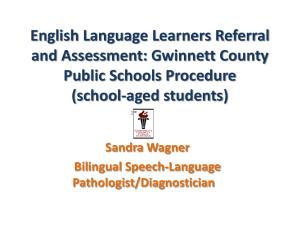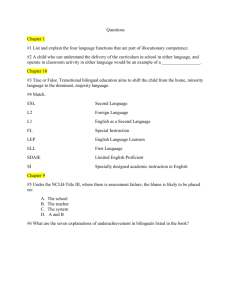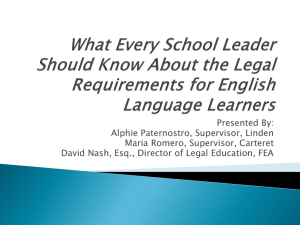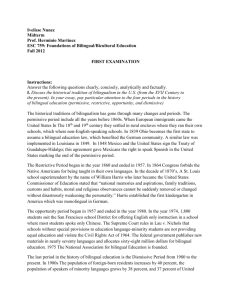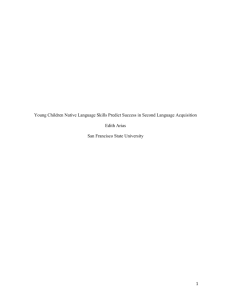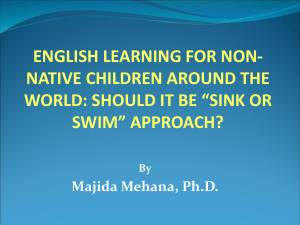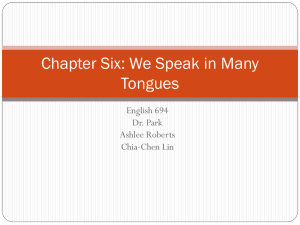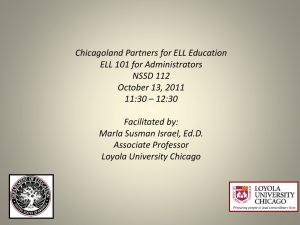Second Language Acquisition & Bilingual Development Impact
advertisement
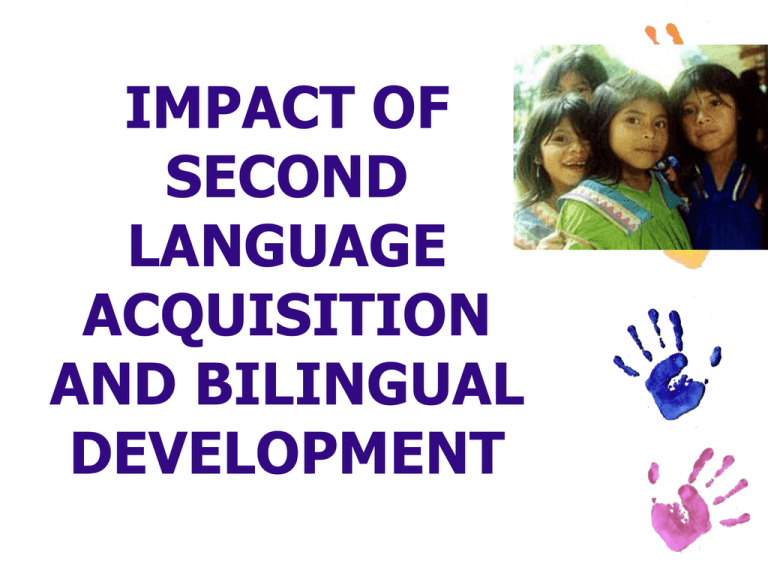
IMPACT OF SECOND LANGUAGE ACQUISITION AND BILINGUAL DEVELOPMENT In order to know what a language impairment (LI) is…** • We need to know what is typical for ELLs who are developing English • Many times, typical characteristics of second language acquisition and bilingualism are mistaken for symptoms of LI I. TYPICAL CHARACTERISTICS OF BILINGUALISM AND SECOND LANGUAGE ACQUISITION A. Language Loss** • Many ELL students’ L1 is not maintained in school through bilingual education • Unfortunately→ language loss in L1 • Thus, low test scores in both L1 and English B. Interference/Transfer** • When students are learning an L2, they make errors that reflect the influence of L1 • For example: in Spanish, a child would say “la casa verde” (the house green) • If a Spanish-speaking child pointed to a picture and said, “look—I see the house green” (instead of “I see the green house”) this would be transfer from Spanish, not a sign of a clinically significant problem with syntax A youtube example of phonological interference:** • The Big Bang Theory Sheldon’s Mandarin Chicken • Sheldon is unhappy because he thinks they changed the recipe, and he is learning Mandarin so he can tell them he wants his Mandarin chicken cooked the old way with the original tangerine peels C. Silent Period** • In the early stages of learning an L2, most students focus on comprehension and do very little speaking • The younger the student, the longer the silent period usually lasts • Students introduced to L2 during the preschool years may speak very little in L1 or in L2 for more than one year D. Interlanguage E. Codeswitching Codeswitching is used by multilingual adults and children around the world** In this youtube video…** • University seniors discuss upcoming exams (Spanish and English) • Youtube channel Celeste Roseberry • “Codeswitching Celeste Roseberry” • http://www.youtube.com/watch?v= NuqXuy3AcBU • F. Avoidance** • Students will avoid communicating in L2 for fear of being laughed at or made fun of • They may be self-conscious about their accent, use of English grammatical structures, and people asking “Where are you from?” (especially older learners) G. Formulaic Language II. Sociocultural Variables** • A. Socioeconomic status — low-income children have difficulty with knowledgebased tests • B. Cultural styles—e.g. reduced eye contact with adults, being silent in the presence of an adult III. Impact of Affective Variables in Second Language Acquisition** A. Motivation— instrumental vs. integrative •B. Personality •C. Self-esteem IV. The Impact of Simultaneous and Sequential Bilingual Acquisition** • Simultaneous: ch is exposed to 2 langs from infancy in natural situations • Interference between L1 and L2 is minimal Early infancy is the ideal time for a child to be exposed to 2+ languages** Sequential acquisition:** • Ch exposed to L1 during infancy, learns L2 at a later time • Sequential learners-↑ diversity in rates and stages of acquisition • **If L2 is introduced sequentially before a strong L1 foundation has been established (e.g., 6-8 years of age), L1 development may be arrested or even regress while L2 is being learned • These students, for a while, achieve low test scores in both L1 and L2— this can cause them to appear LI when they are not • Preschool children who learn English in a sequential manner are especially vulnerable to this situation For example, if a Russian-speaking child is introduced to English in preschool at age 4, he may stop speaking very much in Russian for a time while he is trying to learn English** V. 4 Stages of Second Language Acquisition in Sequential Learners • 1. Stage 1— preproduction: Stage 2—early production: Imagine how this student would perform on this Common Core State Standard: (1st grade English Lang. Arts)** • Define words by category and by one or more key attributes (e.g., a duck is a type of bird that swims and has feathers) • Distinguish shades of meaning among verbs differing in manner (e.g., look, peek, glance, stare, glare, scowl) Stage 3—Speech Emergence: Stage 4: Intermediate Fluency VI. Separate vs. Common Underlying Proficiency** • The Separate Underlying Proficiency (SUP) model holds that L1 and L2 proficiencies are totally separate, and building skills in one language will not help the other language • Believers of SUP try to eradicate students’ L1 through placing these students in “sink or swim” all-English classrooms and telling parents to “speak only English at home” Cummins (1992, 2000) promoted the CUP model, which states:** • “…the literacy-related aspects of a bilingual’s proficiency in L1 and L2 are seen as common or interdependent across languages…experience with either language can promote development of the proficiency underlying both languages, given adequate motivation and exposure to both either in school or in the wider environment” According to the theory of Common Underlying Proficiency…** • Building up one language positively affects the development of the other language • ***Parents need to speak to their child in the language in which they are most comfortable Practical Implications of CUP: Often older learners with a solid L1 foundation perform quite well academically ** Because their solid L1 foundation supports the learning of English and academic content SUP and CUP Unfortunately, many of our ELL students experience limited bilingualism** • These students do not receive L1 support, and they try to learn L2 (English) with a foundation that is not fully developed • These students experience negative cognitive effects and frequent academic failure • They can appear to be “language impaired,” when in reality, they are merely not strong in either L1 or English **VII. CILF and FALF (*based on the work of Jim Cummins) • We can distinguish between two types of language fluency • When conducting assessments of ELLs for the possible presence of a language impairment, it is extremely important to understand • a) what type of language proficiency we are assessing, and • b) if our expectations are reasonable given the student’s length of exposure to English A. Conversational Informal Language Fluency (CILF): There is contextual support for the interaction In this youtube video…(Youtube channel Celeste Roseberry)** • Jovany and Christopher interact about Christopher’s device • Christopher uses English CILF (and some codeswitching between Spanish and English) • Note the informal nature of the conversation and the shared reality • Assessing language difference vs. impairment in ELLs: Conversational Informal Language Fluency • http://www.youtube.com/watch?v=N8w0RjY0zR0 B. FALF (Formal Academic Language Fluency)… For example, this 5th grade science assignment involves FALF:** (not on exam ) • “Condensers are devices that turn gases into liquids by cooling the gas quickly….A condenser can change water vapor to a liquid. The water vapor comes in contact with a cold surface and condenses back into liquid water. It is important to keep the surface cold. The surface normally gets heated by the vapor and so becomes less efficient. In a laboratory condenser, this warming up is prevented by placing the cold surface inside a jacket of cold, flowing water.” The assignment for the 5th grade student reads:** (not on exam!) • Design and conduct an experiment to determine the best surface for condensing water vapor. Predict which surface you think will be best and explain your rationale for this prediction. For some ELLs…** • FALF takes much longer to develop than CILF • If an ELL is proficient and literate in her first language, FALF can develop more quickly • However, if an ELL is from a low-income background and has no literacy skills in the first language, there can be a gap between CILF and FALF development—CILF develops much faster In these cases, when we extrapolate from CILF to FALF… •FALF •CILF Many English language proficiency tests assess just CILF** • A problem with this is that when a CILF-oriented proficiency test labels an ELL student as “Fully English Proficient,” professionals assume the student is ready to handle FALF-oriented tests in English • These can include statewide school achievement tests, speech-language and psychological tests, etc. • The gap between the student’s CILF and FALF performance may lead to erroneous special education placement. VIII. BILINGUAL EDUCATION AND ACADEMIC SUCCESS • A. Introduction Power Differential B. Ideal Bilingual Education Situation • C. Additive vs. Subtractive Bilingualism ***** • Additive bilingualism—the ideal situation, where the student’s L1 is nurtured and developed along with L2 • Research shows that additive bilingualism has great cognitive and linguistic benefits Research in Canada…(Bialystok & colleagues) Neuropsychologist Tamar Gollan at UC San Diego… Other benefits:** • Bilingualismgreater employment opportunities • Children: ethnic pride, cultural tradition, ability to communicate with nonEnglish speaking family members • • • • • Some celebrities are raising their children bilingual: ** (not on exam) Johnny Depp (French) Antonio Banderas (Spanish) Salma Hayek (Spanish) Jessica Alba (Spanish) Julianna Margulies (Russian, German) • Charlize Theron (Afrikaans) • J Lo (Spanish) When we account for second language acquisition phenomena…** • We make many fewer misdiagnoses • We avoid mislabeling typicallydeveloping ELL students as having language impairments • We honor our students’ linguistic and cultural identities as they engage in the challenging and rewarding process of becoming successful, and hopefully proficient bilingual contributors to our society. We need increasing numbers of bilingual U.S. citizens to do business in our continually shrinking world**

